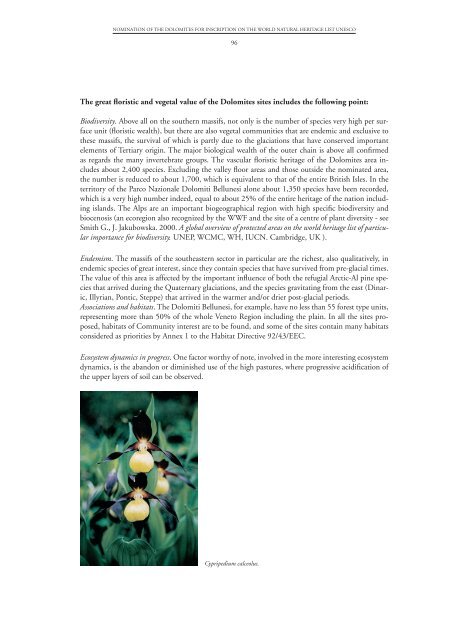DOLOMITES - Annexes 2-8 - Provincia di Udine
DOLOMITES - Annexes 2-8 - Provincia di Udine
DOLOMITES - Annexes 2-8 - Provincia di Udine
You also want an ePaper? Increase the reach of your titles
YUMPU automatically turns print PDFs into web optimized ePapers that Google loves.
NOMINATION OF THE <strong>DOLOMITES</strong> FOR INSCRIPTION ON THE WORLD NATURAL HERITAGE LIST UNESCO<br />
the great floristic and vegetal value of the Dolomites sites includes the following point:<br />
96<br />
Bio<strong>di</strong>versity. Above all on the southern massifs, not only is the number of species very high per surface<br />
unit (floristic wealth), but there are also vegetal communities that are endemic and exclusive to<br />
these massifs, the survival of which is partly due to the glaciations that have conserved important<br />
elements of Tertiary origin. The major biological wealth of the outer chain is above all confirmed<br />
as regards the many invertebrate groups. The vascular floristic heritage of the Dolomites area includes<br />
about 2,400 species. Exclu<strong>di</strong>ng the valley floor areas and those outside the nominated area,<br />
the number is reduced to about 1,700, which is equivalent to that of the entire British Isles. In the<br />
territory of the Parco Nazionale Dolomiti Bellunesi alone about 1,350 species have been recorded,<br />
which is a very high number indeed, equal to about 25% of the entire heritage of the nation inclu<strong>di</strong>ng<br />
islands. The Alps are an important biogeographical region with high specific bio<strong>di</strong>versity and<br />
biocenosis (an ecoregion also recognized by the WWF and the site of a centre of plant <strong>di</strong>versity - see<br />
Smith G., J. Jakubowska. 2000. A global overview of protected areas on the world heritage list of particular<br />
importance for bio<strong>di</strong>versity. UNEP, WCMC, WH, IUCN. Cambridge, UK ).<br />
Endemism. The massifs of the southeastern sector in particular are the richest, also qualitatively, in<br />
endemic species of great interest, since they contain species that have survived from pre-glacial times.<br />
The value of this area is affected by the important influence of both the refugial Arctic-Al pine species<br />
that arrived during the Quaternary glaciations, and the species gravitating from the east (Dinaric,<br />
Illyrian, Pontic, Steppe) that arrived in the warmer and/or drier post-glacial periods.<br />
Associations and habitats. The Dolomiti Bellunesi, for example, have no less than 55 forest type units,<br />
representing more than 50% of the whole Veneto Region inclu<strong>di</strong>ng the plain. In all the sites proposed,<br />
habitats of Community interest are to be found, and some of the sites contain many habitats<br />
considered as priorities by Annex 1 to the Habitat Directive 92/43/EEC.<br />
Ecosystem dynamics in progress. One factor worthy of note, involved in the more interesting ecosystem<br />
dynamics, is the abandon or <strong>di</strong>minished use of the high pastures, where progressive aci<strong>di</strong>fication of<br />
the upper layers of soil can be observed.<br />
Cypripe<strong>di</strong>um calceolus.

















